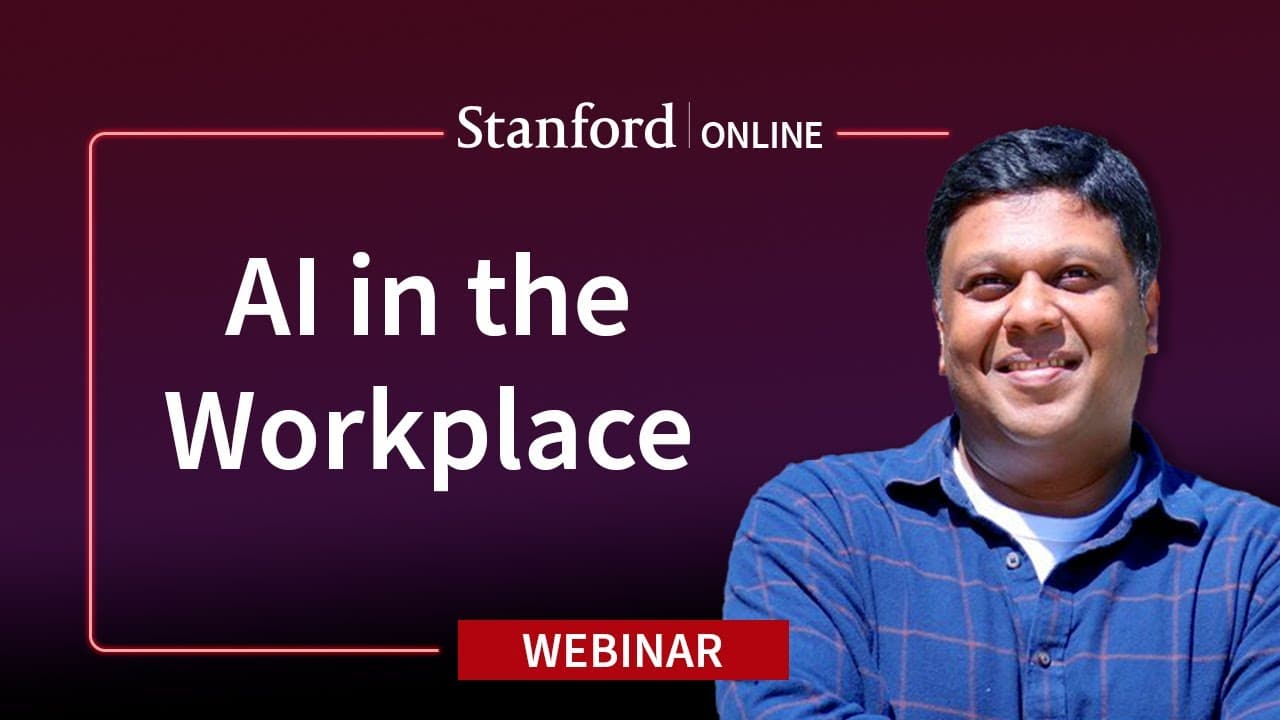AI in the Workplace: Rethinking Skill Development
10 Sep 2024 (1 year ago)

Impact of AI on Work and Skills
- Arvind Kakran is an assistant professor at Stanford University in the department of management science and engineering. (24s)
- His research focuses on how technology, especially emerging technology such as AI, impacts the structure of work, skills and skill development, and has broader implications for organization and strategy. (1m40s)
- Generative AI, such as ChatGPT, is unique compared to previous workplace technologies because it has no pre-built features or functionalities. Instead, its uses are discovered through trial and error as people experiment with it during their everyday work. (6m9s)
- Matt Bean authored a book titled "The Skill Code" that explores the relationship between productivity and skills development in the context of AI. (13m15s)
Challenges and Opportunities in AI Adoption
- There are issues with the adoption and use of AI technologies like ChatGPT and Dolly in the workplace, with many employees not using them regularly or not using them in a way that facilitates experimentation and knowledge sharing. (8m34s)
- It is important for managers to encourage the use of AI in a way that allows employees to develop new skills by taking on more complex tasks, rather than just becoming more productive at their current tasks. (12m21s)
- There is a risk that employees who become more productive through the use of AI without developing new skills will eventually be left behind as technology advances. (12m56s)
A Framework for Understanding AI's Impact
- A three-lens framework for understanding AI's impact on skill development includes strategic design (organizations as machines), power and political (organizations as contests for resources), and cultural (organizations as institutions with shared meanings and practices). (13m41s)
Case Study: Law Firm Implements AI
- A corporate law firm specializing in patent and IP law adopted a legal-specific large language model before ChatGPT's release, primarily for use by paralegals. (17m38s)
- A law firm was deciding how to implement AI technology and chose a decentralized model where each division manager had discretion over how to introduce the technology. (21m16s)
- Two divisions, A and B, were observed using an AI technology called Law Bot, a large language model trained on the legal services industry. (21m27s)
Contrasting Approaches to AI Implementation
- Paralegals in division A used Law Bot 58% more than those in division B and experimented with the technology more, discovering new use cases such as legal research. (22m52s)
- Managers in division A framed the introduction of new technology, Law Bo, as a skill development opportunity for paralegals rather than just a productivity tool. (31m55s)
- Paralegals were encouraged to use Law Bo to complete tasks they disliked faster, allowing them more time to engage in complex tasks like legal research and strategy meetings. (33m21s)
- Managers actively supported the paralegals by providing training, mentorship, and slack time to experiment with Law Bo, fostering a positive learning environment that encouraged the use of the technology. (34m14s)
- Paralegals in Division B viewed the new AI technology, "Law Bot", as a threat to their expertise and job security, leading to a lack of trust and minimal usage. (28m10s)
- The lack of trust in Law Bot resulted in paralegals in Division B focusing on negative experiences with the technology, further diminishing their willingness to experiment and discover new use cases. (29m43s)
- The introduction of Law Bot in Division B was framed as a generic productivity tool with little emphasis on skill development or career mobility for the paralegals. (27m22s)
AI and Organizational Change
- A group of paralegals began using AI technology called Lawboard to complete non-disclosure agreements and contracts more efficiently. This allowed them to take on more complex tasks such as legal research and client interfacing. (36m56s)
- This shift in responsibilities resulted in junior attorneys feeling threatened and pushing back against the paralegals' expanded roles. The junior attorneys believed there was a limited amount of work, referred to as a "lump of task fallacy," and that the paralegals were encroaching on their territory. (39m30s)
- As a result, managers had to intervene and redesign the roles of both the paralegals and junior attorneys. This included reevaluating reporting structures, performance reviews, and workload distribution as the paralegals began taking on more business development tasks. (41m34s)
- To see the positive impacts of generative AI, organizations need to rethink their entire structure and view the implementation of AI as a system-wide endeavor. (42m17s)
Fostering a Culture of Experimentation and Learning
- Managers should incentivize the use of AI for skill development and performing more complex tasks rather than focusing solely on productivity improvements. (42m43s)
- When measuring the impact of AI, it's crucial to look beyond productivity and ROI and instead focus on the development of new skills and the ability to take on new types of tasks. (44m18s)
- Companies were reluctant to give employees slack time to experiment with AI, believing that time could be used better elsewhere. They failed to realize the value of experimentation in discovering how AI can be used effectively. (48m4s)
- A culture of experimentation with AI is important, where employees have the freedom to explore its capabilities and discover how it can benefit their work. (48m24s)
- Psychological safety is crucial when implementing AI. Employees should feel safe to experiment, make mistakes, and explore the technology without fear of penalization or job security. (51m0s)
AI-Powered Training and Development
- Companies are moving away from traditional employee training methods like videos because they are ineffective at teaching new skills. (54m58s)
- Companies are starting to use AI-powered bots for job-specific training, such as negotiation or supply chain optimization. (55m8s)
- Employees are using these bots as part of their daily work, leading to better knowledge retention and improved task performance. (55m30s)